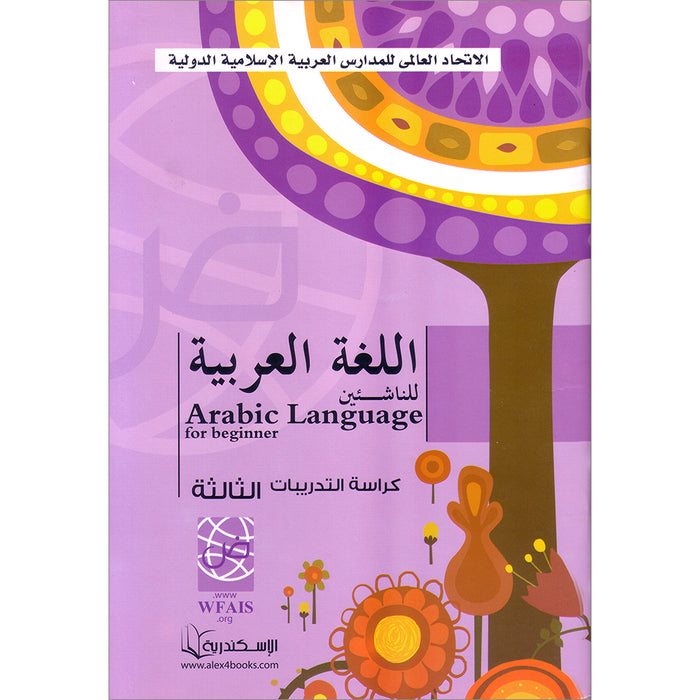Objectives of the book:
- Deepening family connection, parents’ obedience.
- Introducing animals, their different names and types.
- Knowing the advantage of Islamic greeting and its effect in the community.
Grammatical structures:
- Using the original marks (Formation).
- Knowing Al-Madd with Alf and ya’a.
- Solar Letters - Lunar letters.
- 3rd person pronoun.
- 2nd person pronoun.
The linguistic resources:
- A group of lessons about family.
- Sourat Quraish.
- Lessons about animals.
- Lesson (Islamic greeting).
- Lesson (In the name of Allah).
This series seeks to teach children and enhance the linguistic skills for non-Arabic speakers.
Here are some of the highlighted objectives:
- Endearing Arabic language to students and enable them to understand its meanings when listening.
- Allow students to read Arabic language a correct loud reading while getting through what they are reading.
- Enrich students with great linguistic resources so they would be able to format correct Arabic sentences.
- Educate students with the features of Arabic and Islamic culture.
- Allow students to learn other subjects in Arabic.
- And all this would help students to recite The Holy Quran, understand its meanings and perform Islamic rituals in Arabic.
This series relays on five main fundamentals are:
- Psychological bases.
- Linguistic bases.
- Cultural bases.
- Educational bases.
- Social bases.
From here students will learn the linguistic skills in the following order:
- Listening skill
- Speaking skill.
- Reading skill.
- Writing skill.
We would like to point out the recommended teaching methods for teaching these different linguistic skills:
Listening and speaking skills: teaching listening and speaking skills aims to:
- Accustom students to Arabic sounds.
2
- To aware students to the changing meanings by changing tones in one sentence.
- Allow students to mimic the teacher in speech.
- Allow students to understand what is heard.
- The ability to continue listening to Arabic conversations.
- The ability to speak Arabic language a regular speech similar to our children.
Reading skill: the method of teaching the reading skill will progress according to what education scientists call (the Synthesis method) which is based on benefiting the following methods:
- The total method.
- The partial method.
- The combination method.
- The analysis method.
- The vocal method.
The writing skill: the method which is used for this skill in this series books is the direct dictation which benefit from the different dictation methods and they are:
- Imparted dictation.
- Visual dictation.
- Audible dictation.
- Experimental dictation.
Time plan:
The books of this series are school books so the time that is acted for is measured by the time of a class which is 45 minutes and we call each class an hour study that means the days specified to study this book may increase or decrease according to the hours specified for a day of studying.
Language used in teaching:
The teacher is obligated to speak, explain, analyze and discuss in formal fluent Arabic language, and he is not allowed to use an intermediary language whatever that language was.
الكتاب الثالث
أهداف الكتاب
- تعميق الانتماءإلى الأسرة، وبر الوالدين.
- التعرف على أسماء الحيوانات المختلفة وأنواعها.
- معرفة فضل إلقاء السلام وأثره فى المجتمع.
التراكيب اللغوية
- ستخدام العلامات الأصلية (التشكيل).
- معرفة المد بالألف والياء.
- اللام الشمسية واللام القمرية.
- ضمير الغائب.
- ضمير المخاطب.
الثروة اللغوية
- مجموعة دروس عن الأسرة.
- سورة قريش.
- دروس عن الحيوانات.
- درس (تحية الإسلام).
- درس (بسم الله).
هذه السلسلة تسعى إلى تعليم المهارات اللغوية وتنميتها عند الأطفال الناطقين بغير العربية.ومن أبرز أهداف هذه السلسلة ما يلى:
- تحبيب اللغة العربية فى نفوس الدارسين، وتمكينهم عند الاستماع إليها من فهم معانيها.
- تمكين الدارسين من قراءة اللغة العربية قراءة جهرية صحيحة مع فهم معنى المقروء.
- إمداد الدارسين بثروة لغوية كبيرة، لتيسر لهم تكوين الجمل العربية الصحيحة.
- التعرف على ملامح الثقافة الإسلامية والعربية.
- تمكين الدارسين من تعلم المواد الدراية الأخرى باللغة العربية.
- وهذا كله من شأنه أن يعين الدارسين على تلاوة القرآن الكريم وفهم معانيه وأداء الشعائر الدينية باللغة العربية.
وتقوم هذه السلسلة على خمسة أسس رئيسية هى:
- الأسس النفسية.
- الأسس اللغوية.
- الأسس الثقافية.
- الأسس التربوية.
- الأسس الاجتماعية.
ومن هنا سوف يتم تعليم الدارسين المهارات اللغوية حسب الترتيب التالى:
- مهارة الاستماع.
- مهارة الحديث.
- مهارة القراءة.
- مهارة الكتابة.
ونود الإشارة هنا إلى طرق التدريس التى نوصى باتباعها فى تدريس المهارات اللغوية المختلفة:
- مهارتا الاستماع والحديث: تدريس مهارتى الاستماع والحديث يهدف إلى:
- إلف الدارسين للأصوات العربية.
- أن يدرك الدارسون تغير المعنى بتغير النبر أو التنغيم فى الجملة الواحدة.
- تمكين الدارسين من محاكاة المدرس فى النطق.
- تمكين الدارسين من فهم المسموع إليه.
- القدرة على متابعة الاستماع إلى الأحاديث العربية.
- القدرة على التحدث باللغة العربية حديثًا عاديًّا مماثلا لحديث أبنائها.
- مهارة القراءة: طريقة تدريس مهارة القراءة سوف تسير حسب ما يسميه علماء التربية بالطريقة (التوليفية) التى تقوم على الاستفادة من الطرق الآتية:
- الطريقة الكلية.
- الطريقة الجزئية.
- الطريقة التركيبية.
- الطريقة التحليلية.
- الطريقة الصوتية.
- مهارة الكتابة: تقوم الطريقة التى تسير عليها مهارة الكتابة فى كتب هذه السلسلة على طريقة الإملاء المباشر الذى يستفيد من طرق الإملاء المختلفة وهى:
- الإملاء المنقول.
- الإملاء المنظور.
- الإملاء المسموع.
- الإملاء الاختبارى.
الخطة الزمنية:
كتب هذه السلسلة عبارة عن كتب مدرسية، لذلك فإن الوقت المرسوم لها يقاس بالحصة الدراسية التى مقدارها 45 خمس وأربعون دقيقة، ونطلق على كل حصة ساعة دراسية.
ومعنى هذا أن الأيام المخصصة لدراسة هذا الكتاب تزيد أو تنقص حسب الساعات التى تخصص يوميا لدراسته.
اللغة المستخدمة فى التدريس:
المدرس القائم بعملية التدريس مطلب بالتحدث أو الشرح أو التحليل أو المناقشة باللغة العربية الفصيحة، ولا يجوز له استعمال لغة وسيطة مهما كانت هذه اللغة.


























